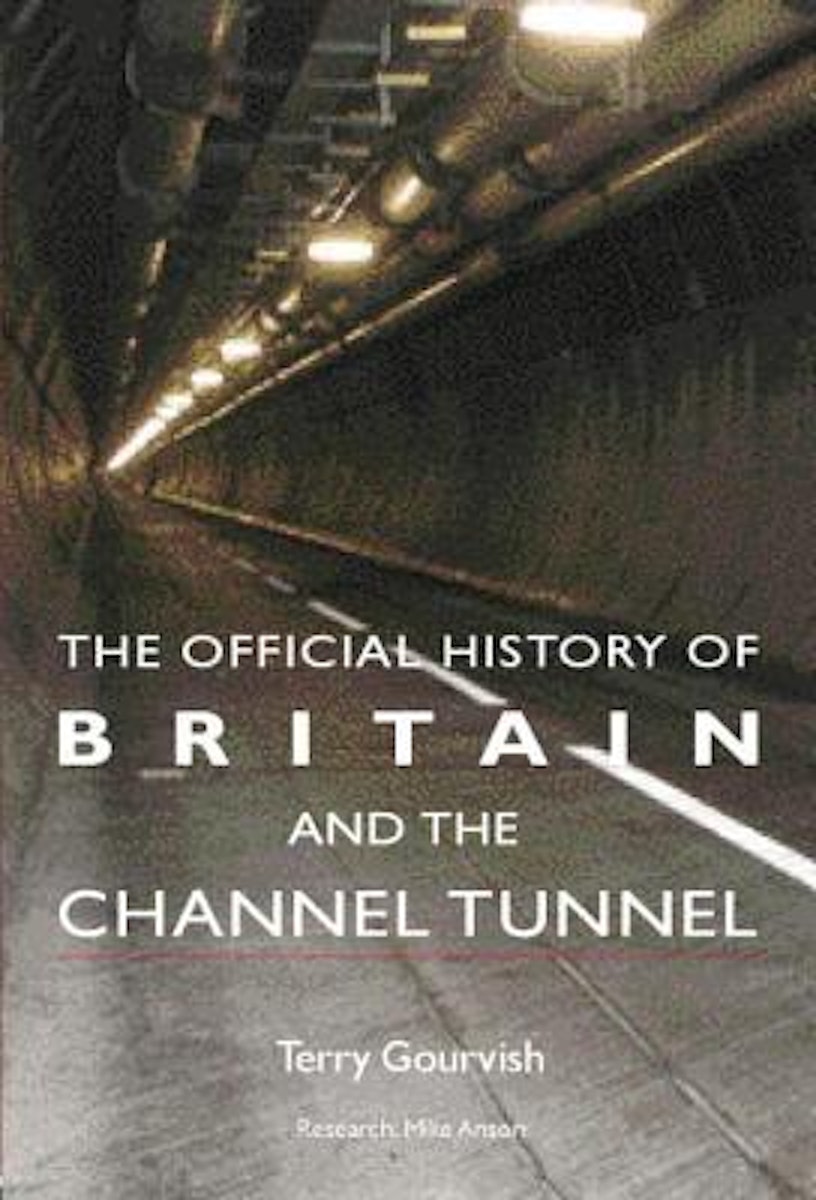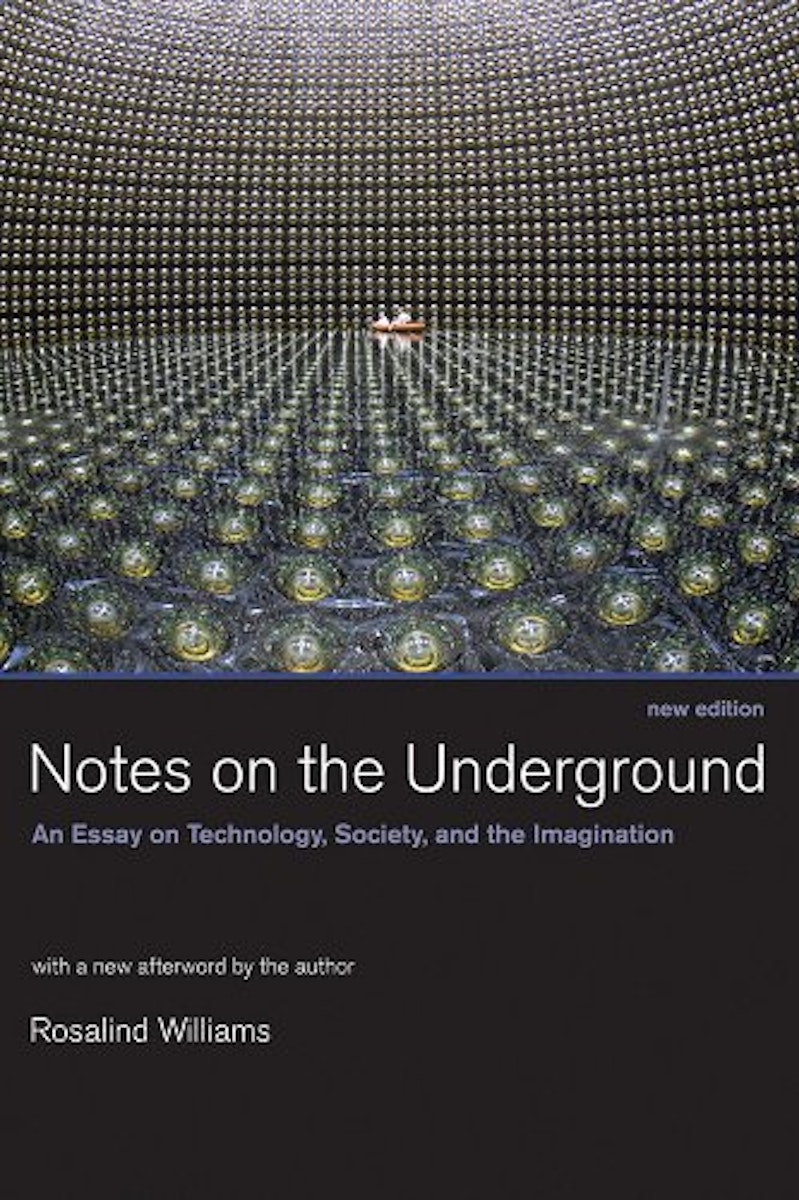
Liberal Visions and Boring Machines The Early History of the Channel Tunnel
More than a century before the Eurostar and LeShuttle, a group of engineers and statesmen dreamed (and fretted) about connecting Britain to France with an underwater tunnel. Peter Keeling drills into the history of this submarine link, and finds a still-relevant story about the cosmopolitan hopes and isolationist panic surrounding liberal internationalism.
January 10, 2024
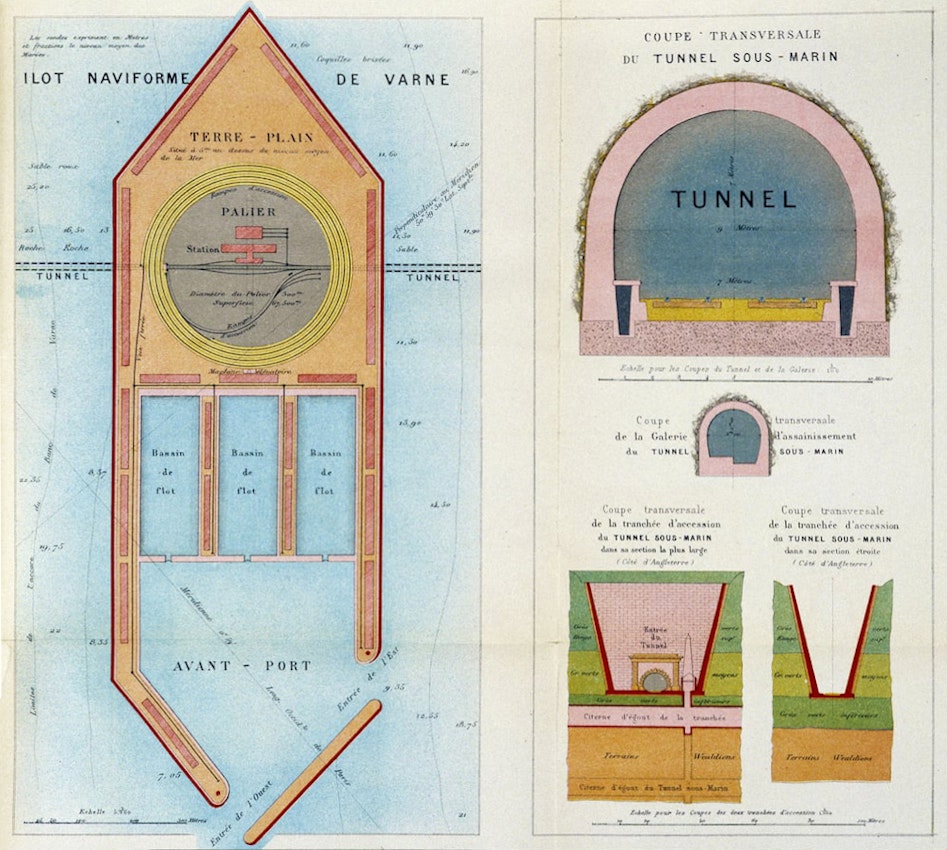 Scroll through the whole page to download all images before printing.
Scroll through the whole page to download all images before printing.Thomé de Gamond’s plans for an underwater tunnel between England and France, produced for the World Exposition of 1867. The yellow circles, top left, represent an enormous spiral ramp allowing access to the tunnel from an international artificial island on the Varne sandbank — Source.
The English Channel (la Manche, “the sleeve”, to the French) is one of the roughest sea crossings in the world. At its narrowest, in the Strait of Dover, it is a mere twenty miles across, but for those attempting the crossing this brevity is of little comfort. The Strait’s shallowness, combined with its unique tidal streams, ocean currents, and regular fog, make for a turbulent and hazardous journey, and the sea sickness it induces is notorious.
For centuries, the Channel was Britain's bulwark against foreign invasion. The vicious weather was given a divine interpretation as the “protestant wind” which sunk the Spanish Armada in 1588. But this was a double-edged sword: merchant shipping was as vulnerable as Phillip II’s great fleet. With the industrial era came peace and increased trade, and by the early nineteenth century the UK was the largest producer of manufactured goods in the world. Improvements in shipping and port facilities greatly facilitated trade, but the logistical problem of transferring goods from ship to shore remained. Unsurprisingly, faced with this issue, thoughts began to turn toward methods of avoiding the water altogether. In 1785, the trip was first made by balloon, but the first aeroplane would not follow until 1909. In 1851, a telegraph wire linked London and Paris directly. Might it be possible for a railway to follow? Many engineers believed it was: they proposed a tunnel, joining the roads and railways of Britain to those of mainland Europe.
But this was not simply a problem of engineering and geology. The idea of a fixed link was deeply intertwined with the issue of how the British understood international relations and their place in Europe during the age of imperialism. On the one hand stood those who believed in a shared European liberalism, founded on a belief in “the people” and the unifying power of international communications and free trade. For these champions of progress, great railway projects represented the spirit of the age: iron rails “knitting together the hearts of nations”, as one proponent would put it. Opposing this were Britons of a more pessimistic and suspicious disposition, who regarded Europe as permanently riven by diplomatic, military, and imperial tensions. For them, railways were a weapon, and the proposed channel tunnel a military frontier, exposing their wealthy and unprepared island to the massed armies of mainland Europe. It was this clash of worldviews, not the engineering challenge, that would decide the fate of the project.
_against_England_in_1803_by_Napoleon_I-edit.jpeg?fit=max&w=1200&h=850) Scroll through the whole page to download all images before printing.
Scroll through the whole page to download all images before printing.Engraving by an unknown artist envisioning Napoleon’s invasion of England by air, sea, and tunnel, 1803 — Source.
The French Pioneers
In 1802, during a lull in the Napoleonic wars, an otherwise unknown French mining engineer named Albert Mathieu proposed what is thought to be the first plan to bypass the Channel. He envisioned a tunnel ventilated by enormous iron chimneys, projecting above the sea, as well as an artificial “international island”, relay station (to allow carriages to change horses), and harbour on the Varne sandbank at the Strait’s midpoint. The plans were prominently exhibited at the French school of mines and in the legislature, where Napoleon Bonaparte presumably first saw it. Bonapate brought it to the attention of the British opposition politician Charles James Fox, who is said to have reacted enthusiastically. However, the project was abandoned with the return of war.1
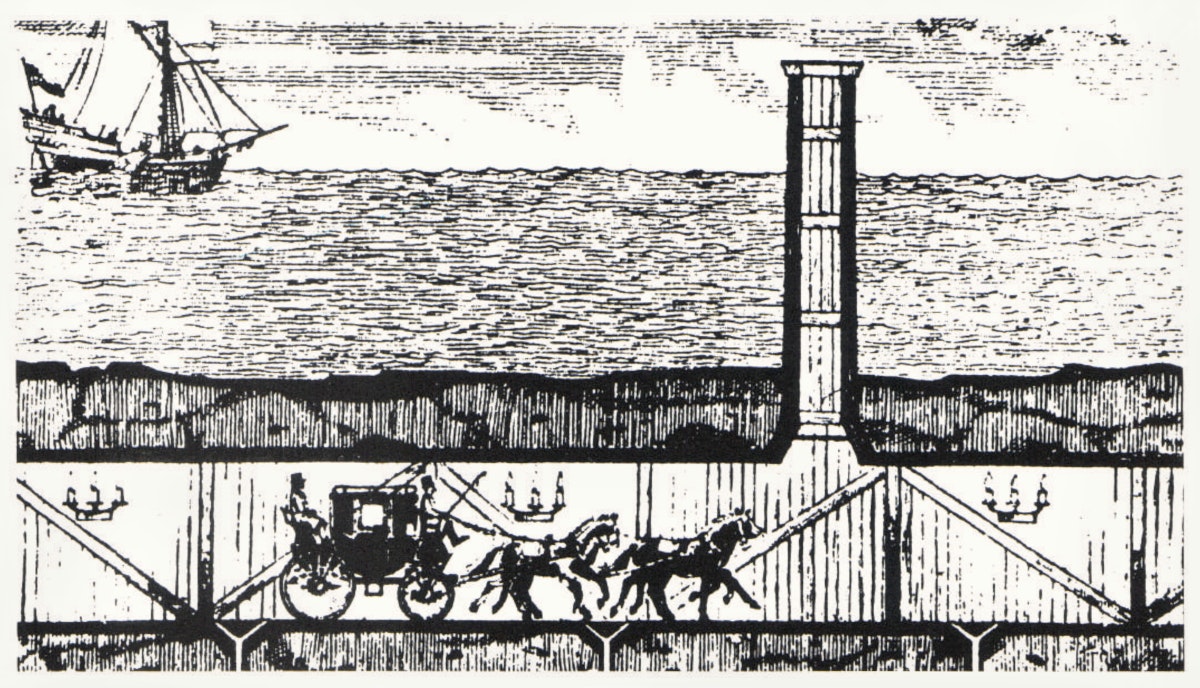 Scroll through the whole page to download all images before printing.
Scroll through the whole page to download all images before printing.Illustration of Albert Mathieu’s plans for a horse-drawn coach service across the Channel aerated by ventilation chimneys, ca. 1802 — Source.
Three decades later, Mathieu’s mantle was taken up by the man most deserving of the accolade “Father of the Channel Tunnel”, Aimé Thomé de Gamond. The very picture of a nineteenth-century renaissance man — alongside his studies in geology and engineering, he also acquired a doctorate in medicine and law — Thomé de Gamond became fascinated by the idea of a link across the Channel while researching rivers in France. By the end of the 1830s, he had produced a wide variety of plans, from vast bridges, to iron tubes, to a masonry tunnel on the seabed.
Thomé de Gamond was not alone in his desire to join Britain to the Continent.2 Due to a lack of geological knowledge, however, few of his peers dared propose a tunnel underneath the seabed. While studies had shown the strata of the English and French coasts to be identical, it was not known whether the Strait of Dover itself had been created by the two coasts moving apart to create a rift valley, or the erosion of an ancient land bridge which once connected Kent to Northern France. If the strait was a rift, then a tunnel would be difficult, if not impossible — any attempt would be tunnelling into unknown and inconsistent geology, potentially containing hard rock requiring an enormous outlay in manual labour or explosives.
 Scroll through the whole page to download all images before printing.
Scroll through the whole page to download all images before printing.“Sectional Diagrams of the Proposed Tubular Submarine Between France and England”, an illustration of the proposal by Hector Horeau, one of Thomé de Gamond’s early Tunnel-dreaming peers, for a tubular submarine railway — Source.
After exhausting all terrestrial research methods, Thomé de Gamond set out to solve the mystery of the strait via three extraordinary solo dives in 1855. Weighed down by 160 pounds of flint, he stoppered his ears with home-made plugs of lard, and turned his mouth into a de facto valve, using olive oil to expel air without taking in water. Thus equipped, he successfully descended over one hundred feet to collect soil samples from the seabed, ascending afterward with the help of ten inflated pig bladders. On his final dive, the renaissance man found himself fending off an attack by conger eels.3
The adventure paid off. Examination of the samples confirmed that Britain and France had once been connected by a landmass since eroded away, and that the geological strata were continuous between the two coasts. Because the rock was soft chalk, the work would not require laborious drilling and dynamite. A bored tunnel became feasible for the first time.
The Spirit of the Age
Thomé de Gamond’s discovery came at a fertile moment in European intellectual and scientific history. The Continent’s rapidly expanding technological, industrial, and economic power — and the imperial arrogance it fuelled — had produced an intoxicating cult of scientific progress to whom all things seemed possible.4 Railways were at the cutting edge of this new world. The first commercial railway, between Liverpool and Manchester, had opened in 1830, and by 1850 over 20,000 kilometres of tracks crisscrossed Europe.
Tunnels were an integral part of railway construction from the start, but during the second half of the century they were accomplished on an altogether more heroic scale. In 1871, the Mont Cenis Tunnel connected France and Italy through the Alps, followed in 1882 by the nine-mile Gotthard Tunnel, then the longest in the world. Four years later England and Wales were linked by four miles of tunnel underneath the Severn River estuary. These feats of engineering “incarnated what the age understood as progress”, writes Rosalind Williams.5 The completion of each line was celebrated as a triumph of science over nature, and their designers and builders feted as men at the vanguard of civilisation’s steady march. In this context, the lack of a link across the English Channel was more than an anomaly, it was a failure of economic and social progress. As the engineer and tunnel advocate James Chalmers wrote in 1861:
Glancing over the Railway Map of Europe, the intelligent eye traces numerous lines tending to certain points, almost invariably to great cities. There is, however, one remarkable exception to this general rule: on the Continent, from North, East, and South, and in England from South, West, and North, lines are seen drawing together, stretching out their iron arms as if they would embrace, when, lo! they have stopped.6
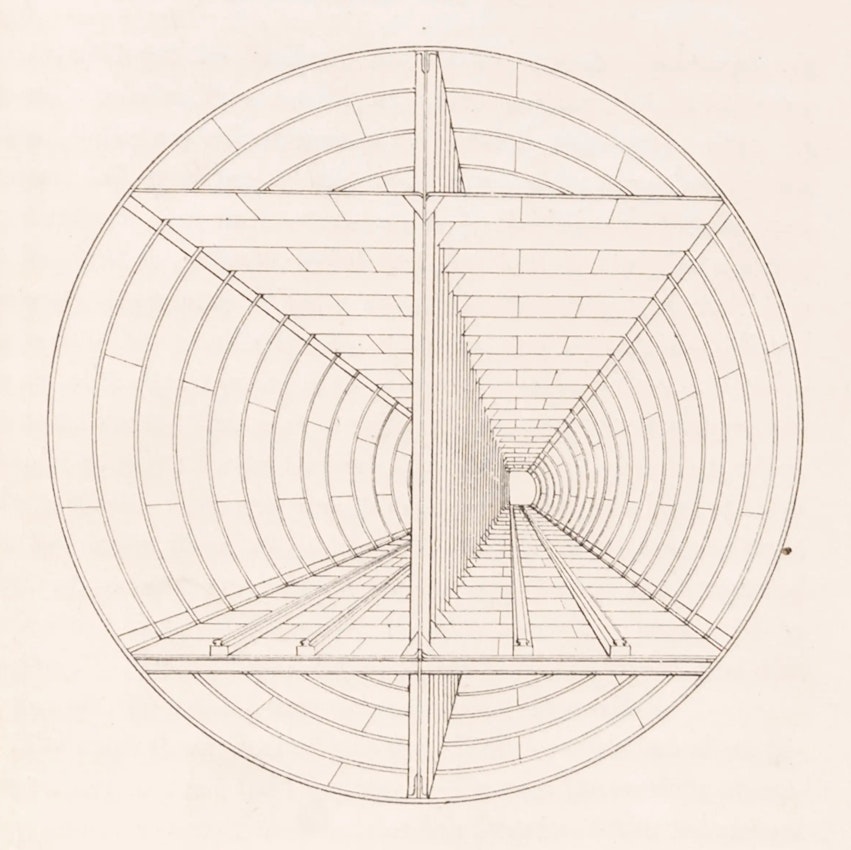 Scroll through the whole page to download all images before printing.
Scroll through the whole page to download all images before printing.Title-page illustration of James Chalmers’s “Channel Railway” from his The Channel Railway Connecting England & France (1861) — Source.
The enthusiasm for technological progress went hand-in-hand with the rise of a self-confident liberal internationalism, encapsulated in events such as the 1851 Great Exhibition in London and 1860 Anglo-French free trade treaty. The chief architects of the treaty, Richard Cobden and Michel Chevalier, taught that the underlying forces in history were moving inexorably toward the unity of humanity: improved trade and communications would eventually render warfare obsolete.7 They idealised “the people” and attacked “vested interests” in the armed forces and aristocracy, whom they believed were the real drivers of international conflict. “Free Trade is God’s diplomacy”, Cobden once wrote, “and there is no other certain way of uniting people in the bonds of peace.”8 Both Cobden and Chevalier came to support the Channel Tunnel project, seeing it as an important step toward the eventual unification of Europe, a “true arch of alliance”, in words attributed to Cobden and often quoted by tunnel advocates.9
The fruits of Thomé de Gamond’s labours ripened in 1856, with a comprehensive proposal for a double-track railway tunnel connecting East Wear Bay, near Folkestone, to Cap Gris-Nez in Pas-de-Calais. Like Mathieu, he envisaged an international port on the Varne Bank, with ventilation shafts and lighthouses lining the route. Construction would begin from temporary stone islands built at intervals across the Channel, from which the ventilation shafts would be sunk, and the tunnel would employ steel “shields” of the kind pioneered in the construction of the Thames tunnel. Hailed by leading engineers including Robert Stephenson and Isambard Kingdom Brunel, and with the support of Queen Victoria, Prince Albert, and Napoleon III, the scheme seemed on the road to realisation, “an end”, according to its inventor, “as useful as it is glorious”.10
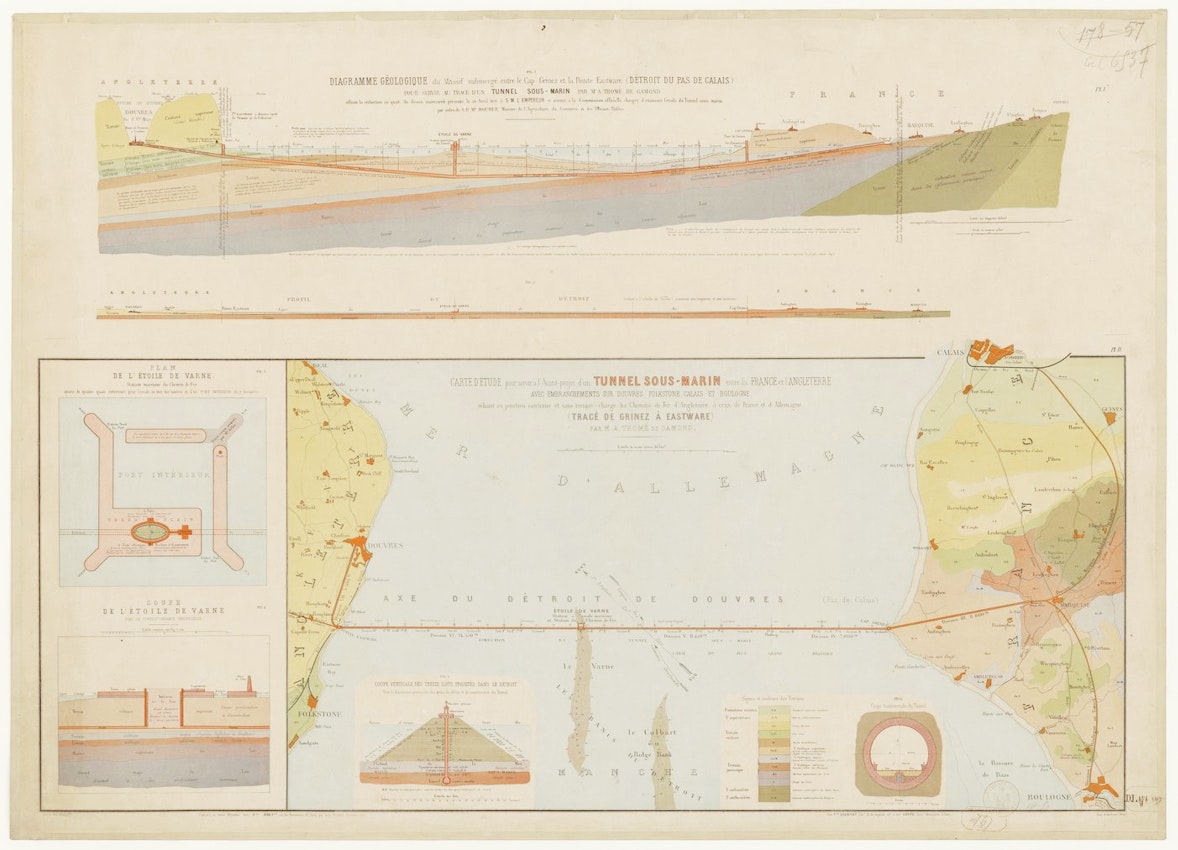 Scroll through the whole page to download all images before printing.
Scroll through the whole page to download all images before printing.Map showing Thomé de Gamond’s preliminary designs for a tunnel linking England and France, 1857 — Source.
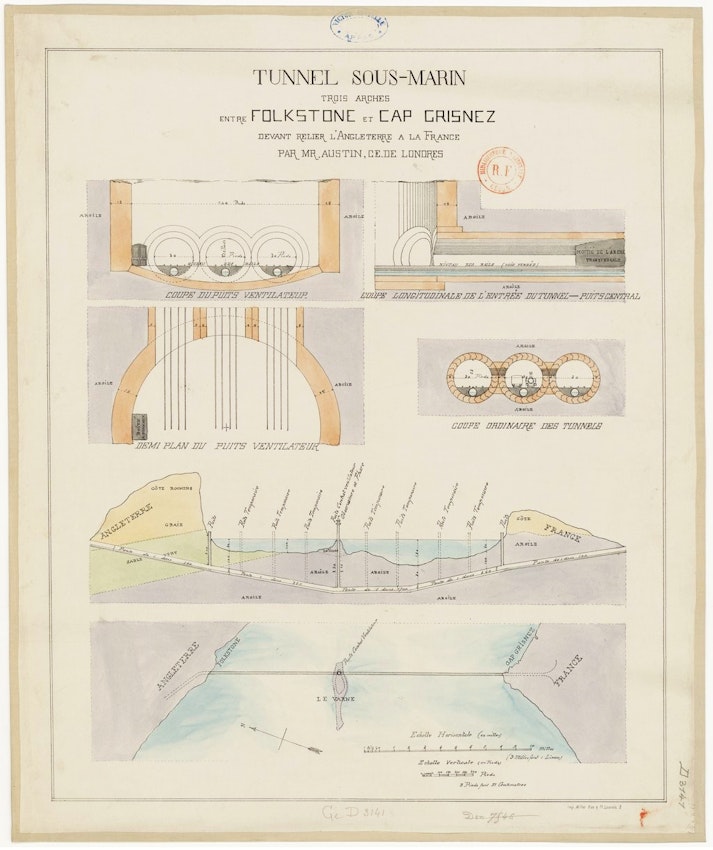 Scroll through the whole page to download all images before printing.
Scroll through the whole page to download all images before printing.Designs for a tunnel linking Folkstone, England, and Cap Grisnez, France, credited to Mr. Austin of London, ca. 1850s — Source.
However, in a series of events which would become grimly familiar to supporters of the Tunnel, the project foundered amid a breakdown of relations between the two nations. Following an attempt on Napoleon’s life by an Italian nationalist with a bomb made in Britain, an invasion scare was whipped up by the British press. This was cynically exploited by the Francophobe Prime Minister Lord Palmerston, who used the opportunity to ring Plymouth and Portsmouth with expensive and useless fortifications. The antithesis of the optimistic liberal, Palmerston thought that a tunnel would remove “our natural defence against a continental enemy”.11 Cobden and Chevalier believed him to be obsessed with the Napoleonic wars of his youth: “his mind is haunted with ideas of a French invasion”.12 This was the world-view, pessimistic and suspicious, which Tunnel advocates would have to overcome if their project was to succeed.
The British Dive In
During the 1860s, Thomé De Gamond was joined by British engineers including William Low and John Hawkshaw, who dropped the Varne bank idea to focus on the stretch of sea directly between Dover and Calais. Extensive soundings and surveys were conducted, and by the end of the decade a joint Anglo-French committee had been established to take the project forward.
In 1872, a British Channel Tunnel Company was established, and a French company appeared in 1875. At the suggestion of the British (Palmerston having been replaced as Prime Minister by the more sympathetic Disraeli), an official joint commission with representatives of both nations was set up to establish codes and regulations for the proposed tunnel.13 On August 2, 1875, both nations passed acts empowering their respective companies to begin work.14 Progress, however, stalled less than two years later. Complete proof of viability was still lacking, denting investor confidence. Stymied by financial problems, the British company had achieved little by 1876, when the concessions granted by the 1875 Act expired.
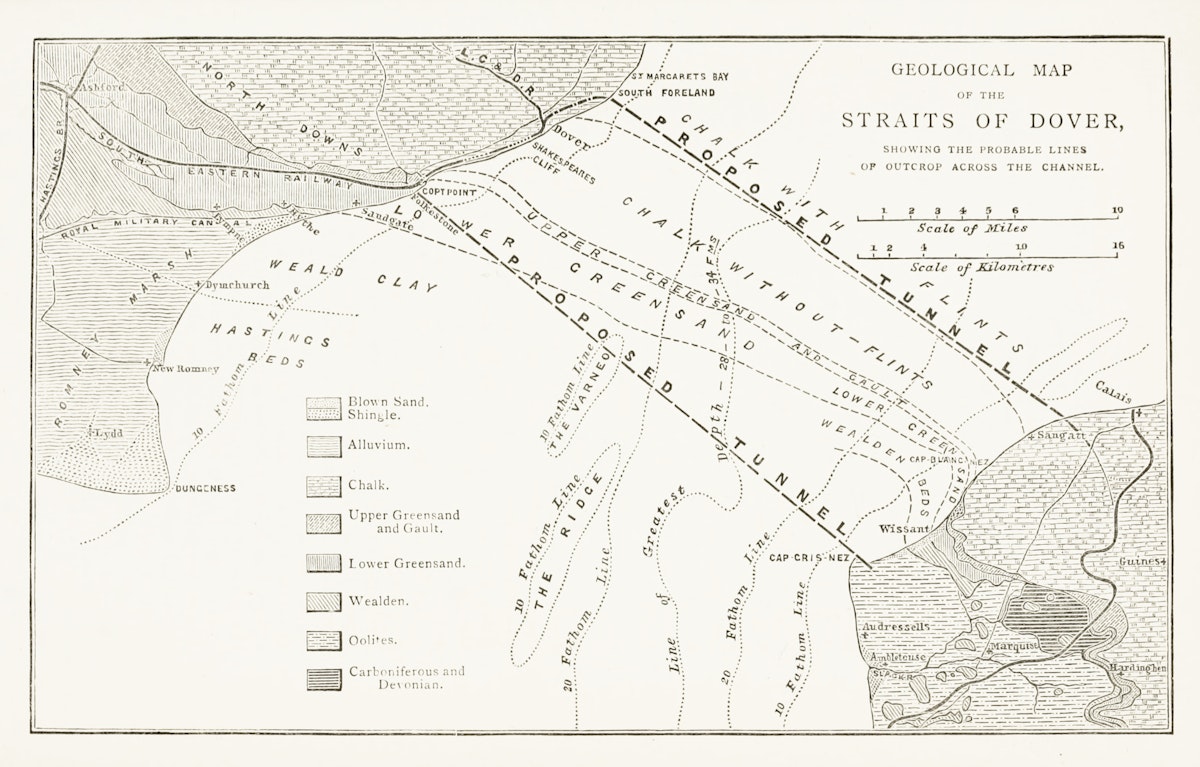 Scroll through the whole page to download all images before printing.
Scroll through the whole page to download all images before printing.“Geological Map of the Straits of Dover Showing the Probable Lines of Outcrop Across the Channel”, from William Topley, “The Geology of the Straits of Dover”, The Quarterly Journal of Science (1872) — Source.
It was at this point that the Tunnel was taken up by Sir Edward William Watkin, the independent Liberal Member of Parliament for Hythe and chairman of three major railways companies, including the South Eastern, which operated throughout Kent. Pugnacious and stubborn, a consummate businessman and publicist with a mind attracted to large and visionary engineering projects, Watkin possessed a passionate belief in the power of free trade.15 He assembled an eminent scientific and legal advisory committee, including lawyers, electrical, hydraulic, and mining engineers, geologists, soldiers, and the President of the Royal Society. But the key individuals were two Royal Engineer officers, Colonel Frederick Beaumont and Captain Thomas English, who finally proved that the Tunnel was viable.
Both were skilled inventors. During the later 1870s, Beaumont was experimenting with locomotives and trams powered by compressed air.16 English was an expert in steel armour plate, the material needed to build durable mining equipment, and in 1880 patented a new boring machine based on a previous design by Beaumont.17 A year later, the two men produced a tunnelling machine using English’s patent, powered by Beaumont’s compressed air engine. The result was a triumph of engineering, the ideal tool for the job. Featuring a revolving cutter which could dig a seven-foot diameter tunnel at a rate of one yard an hour, and a conveyor for the removal of spoil, the machine required fewer than ten men to operate. Crucially, its power source meant that it not only produced no dangerous fumes, but, by releasing air after use, it ventilated the Tunnel as it worked.18
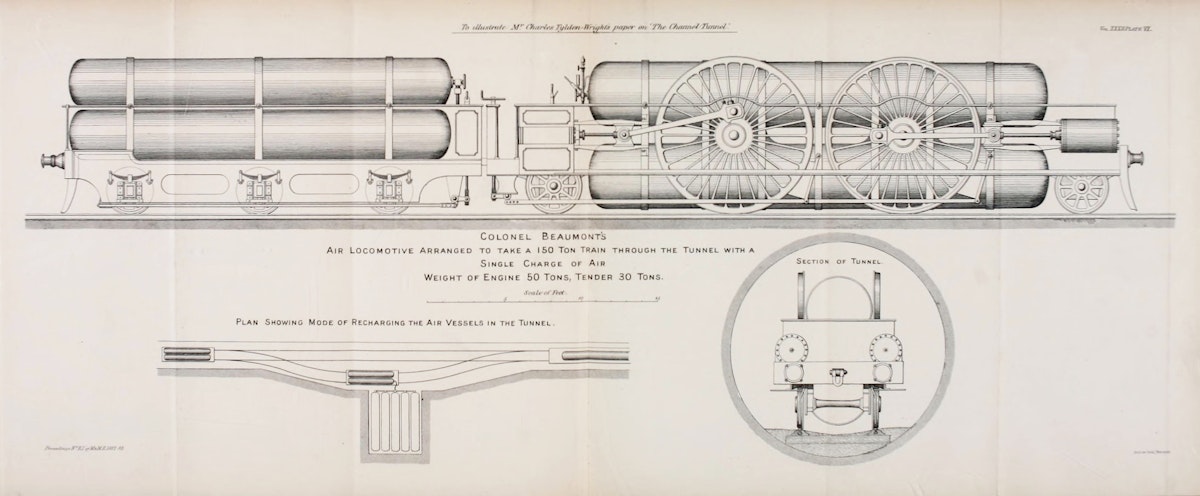 Scroll through the whole page to download all images before printing.
Scroll through the whole page to download all images before printing.“Colonel Beaumont’s Air Locomotive Arranged to Take a 150 Ton Train Through the Tunnel with a Single Charge of Air”, an illustration for Charles Tylden-Wright’s paper on “The Channel Tunnel”, Transactions. The North of England Institute of Mining and Mechanical Engineers, vol. XXXII (1882–83) — Source.
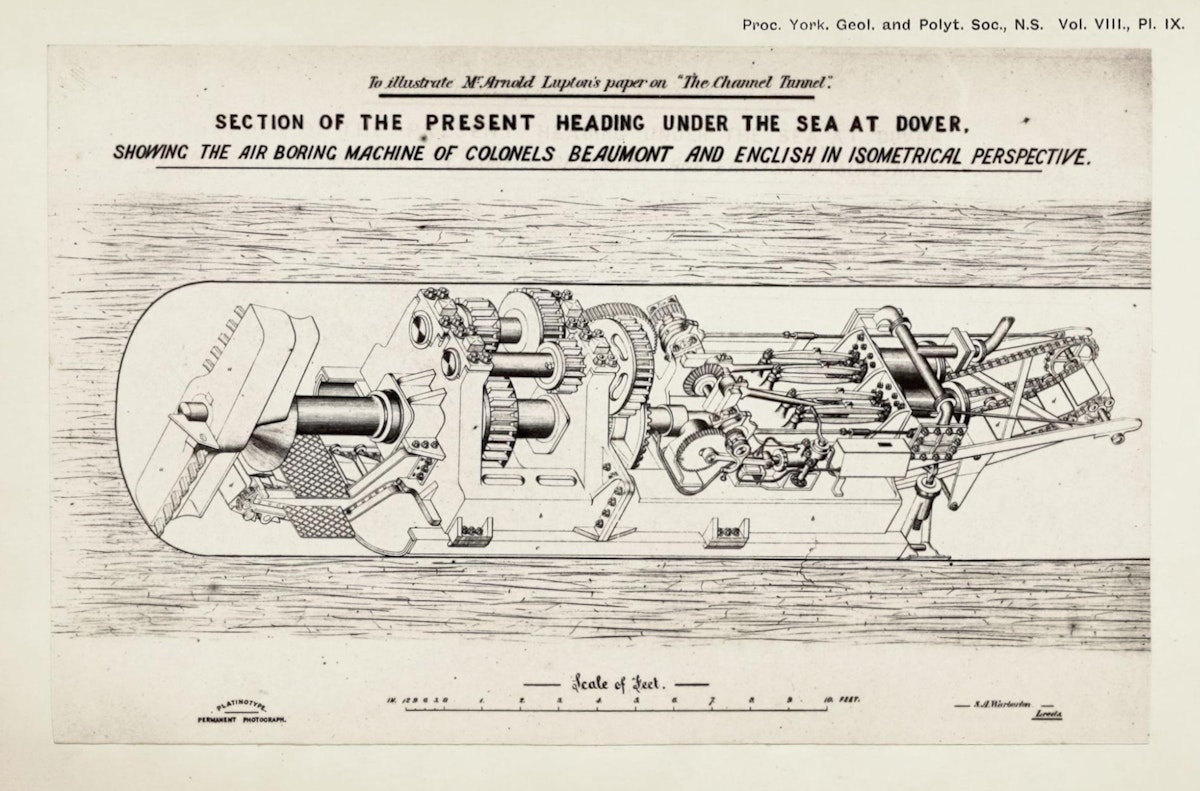 Scroll through the whole page to download all images before printing.
Scroll through the whole page to download all images before printing.“Section of the Present Heading Under the Sea at Dover Showing the Air Boring Machine of Colonels Beaumont and English in Isometrical Perspective”, an illustration for Arnold Lupton’s paper on “The Channel Tunnel”, Proceedings of the Yorkshire Geological and Polytechnic Society, vol. III (1883) — Source.
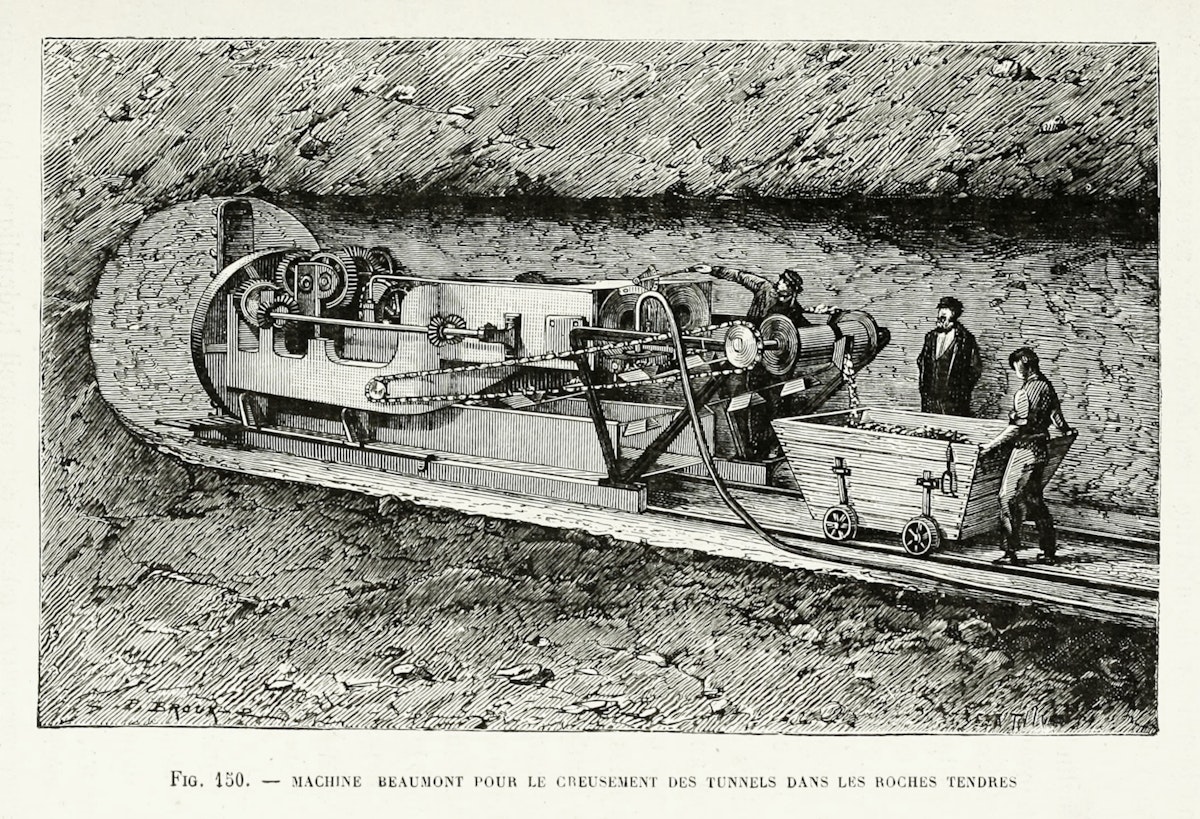 Scroll through the whole page to download all images before printing.
Scroll through the whole page to download all images before printing.“Beaumont Machine for Digging Tunnels in Soft Rock”, an illustration from Louis Figuier, Grands Tunnels et Railways Metropolitains volume of Les Nouvelles Conquêtes de la Science (Paris, 1867) — Source.
On October 14, 1880, the Beaumont-English machine began trial borings at Abbots cliff, near Dover. The layer of grey chalk into which the machine dug was easy to cut, yet practically watertight. In September the next year, after boring 842 yards of test tunnel, the machine was moved to a new site beneath Shakespeare cliff, the closest point between England and France. At the end of the year, Watkin founded the grandiosely named Submarine Continental Railway Company to oversee this work. The French Compagnie du Chemin-de-fer Sousmarine soon started boring out from Sangatte, near Calais, using a modified version of the Beaumont-English machine. For the first time in the history of the project, miners were working underneath the sea.19
-edit.jpeg?fit=max&w=1200&h=850) Scroll through the whole page to download all images before printing.
Scroll through the whole page to download all images before printing.Engraving of the underwater tunnel project between France and England by Frederic de Haenen, ca. 1850–1900 — Source.
“It is one of the proudest moments of my life”, declared Beaumont, “to see the probable realization of what has always been a dream of mine.”20 Beaumont dreamed big. He envisioned an international undersea railway powered entirely by compressed air, with carriages pulled by eighty-ton locomotives that would ventilate the Tunnel as they cruised.21
Boring Toward Brotherhood; Digging to Disaster
In June 1881, Watkin announced to a startled nation that he expected to complete an initial “experimental” tunnel within five years, with a view to opening the line sometime in the 1890s. “I was born an islander, but it is my ambition to die a member of the great European Continent.”22 The only apparent obstacle was the small matter of passing a bill in Parliament to allow the company to tunnel under the seabed, which was Crown property.
The Channel Tunnel was to be the crowning achievement of both international engineering and Watkin’s own career, “a work without an equal among all the labours until now accomplished by the hand of man.”23 But it was also something else: a practical continuation of the work of Richard Cobden, and a concrete step toward an eventual European free trade union. By forging economic and personal links between the populations of Britain and France, the Tunnel would help remove antagonism from the bottom up, allowing a new understanding to “permeate through the masses” of both countries. “It is obvious”, Watkin told the Submarine Continental shareholders, “that the Channel becomes every year more and more of a break, retarding and embarrassing the great interchanges of nations.”
Watkin’s was a particularly British vision of European unity. A staunch patriot as much as an internationalist, he firmly believed that liberty, free trade, and peace were the methods by which Britain had achieved its economic and imperial successes. The Tunnel was a method of exporting these values to the European mainland:
. . . so far from England being, as it were, diluted with the ideas and arts of the Continent, the Continent would benefit by better and closer access to the freedom and industry of England . . . the friendly competitions of labour in all its departments would become a common heritage of blessing to the world at large.
This heady mix of scientific, commercial, and civilizational “progress” was most passionately articulated by Watkin’s lieutenant in Parliament, Lord Brabourne:
In spite of all opposition, science ever advances; in such an issue as the present, civilization and Christianity are marching hand in hand; the obstacles suggested, and perhaps for a time sustained, by insular prejudice and professional pedantry, will pale and fade away before the spirit of the age; and, in the triumph of the Channel Tunnel, one more step will be accomplished in the uniting and knitting together the hearts of nations, and in the nearer approach to the full and blessed recognition of the universal brotherhood of mankind!24
Little seemed to stand in the way of Watkin’s Channel Tunnel in January 1882. Public opinion was supportive, while the Liberal government was led by Watkin’s friend William Gladstone, a known Tunnel enthusiast. Gladstone had won the 1880 general election on a platform of internationalism, peace, and free trade; to Watkin, the Channel Tunnel was an ideal match for these policies.
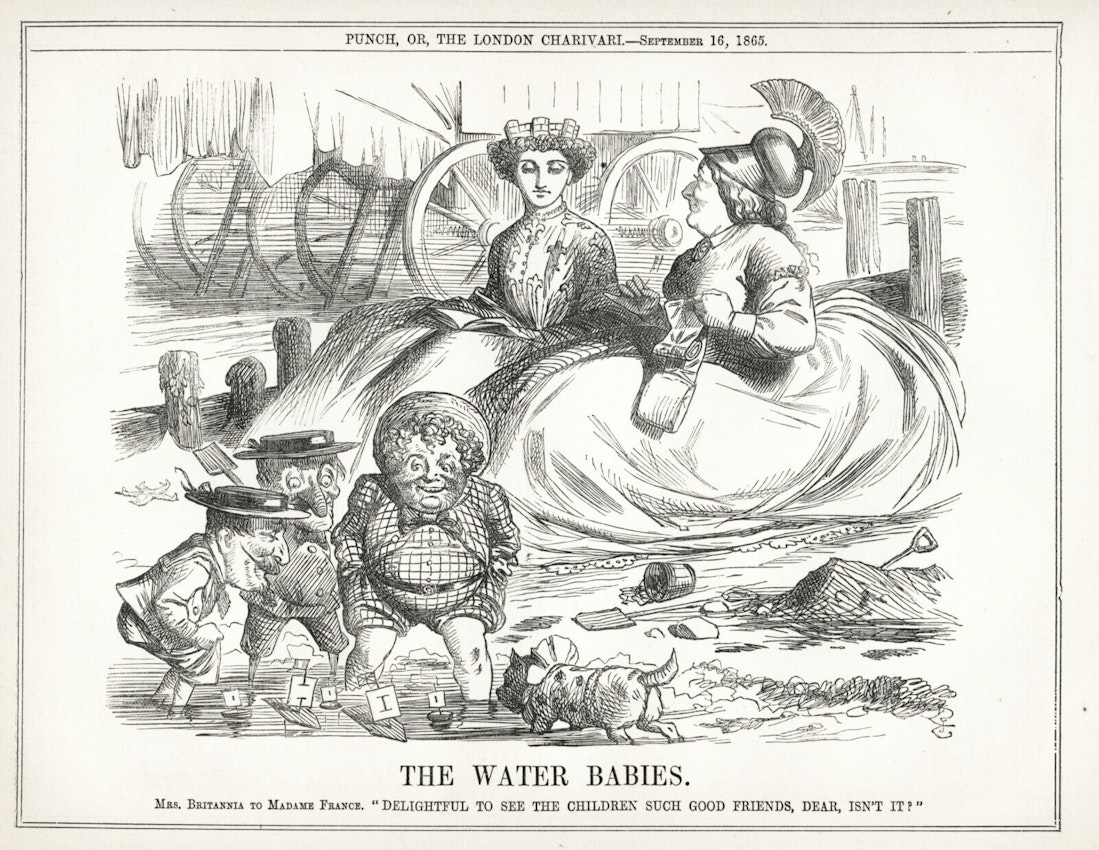 Scroll through the whole page to download all images before printing.
Scroll through the whole page to download all images before printing.An illustration by John Tenniel for an 1865 issue of Punch titled “The Water Babies”, depicting Mrs Britannia saying to Madame France: “Delightful to see the children such good friends, dear, isn’t it?” — Source.
At this moment, however, hitherto suppressed forces burst forth upon the project. Unbeknownst to the public, an official committee consisting of the Board of Trade, the War Office, and Admiralty had been formed in 1881 to examine the implications of the Tunnel. Among the evidence they considered was a memorandum from the Army’s Quartermaster General, Sir Garnet Wolseley.25
While his public image was that of an efficient professional soldier, politically Wolseley was a profound reactionary with an open disdain for the liberal worldview of Cobden, Gladstone, and Watkin. Rather than a measured, technical document, Wolseley’s memorandum on the Tunnel was a furious diatribe against the “specious cry of universal brotherhood” and “selfish cosmopolitans”. In place of Watkin’s optimistic prophesy of Anglo-French amity, Wolseley substituted his own analysis of interstate relations which stressed humanity’s inherently violent and jealous nature.
A chronic pessimist, Wolseley believed that the British Army was dangerously underfunded, a situation he laid directly at the door of liberal internationalists. “Owing to our belief in the virtuous intentions of others”, he wrote, “we live in a constant condition of unpreparedness for war”. In this context, liberal and wealthy Britain was a prize to be seized rather than a civilisation to be emulated. The Tunnel, he argued, would be “a constant inducement to the unscrupulous foreigner to make war upon us, as it would hold out to him hopes of a conquest the like of which the world had never known before”.
Wolseley pointed out that the use of trains during recent wars in the United States and Europe had enabled generals to move troops far further and more rapidly than ever before. To connect Britain with France would expose the UK to the same danger, and he suggested, without evidence, that the Tunnel could be used to bring five thousand soldiers an hour into the country. He imagined a sudden surprise attack during a period of “profound peace”, with no warning and without an official declaration of war, “whilst we gentlemen of England were abed, dreaming of the time when the lion and the lamb are to lie down together”. With London the only unfortified capital in Europe and no large conscript army to rival those of France or Germany, the UK would be quickly overcome. Annexed to the continent and unable to recover behind its protective moat, the British would face “national annihilation”, becoming “the helots of France for ever”.26
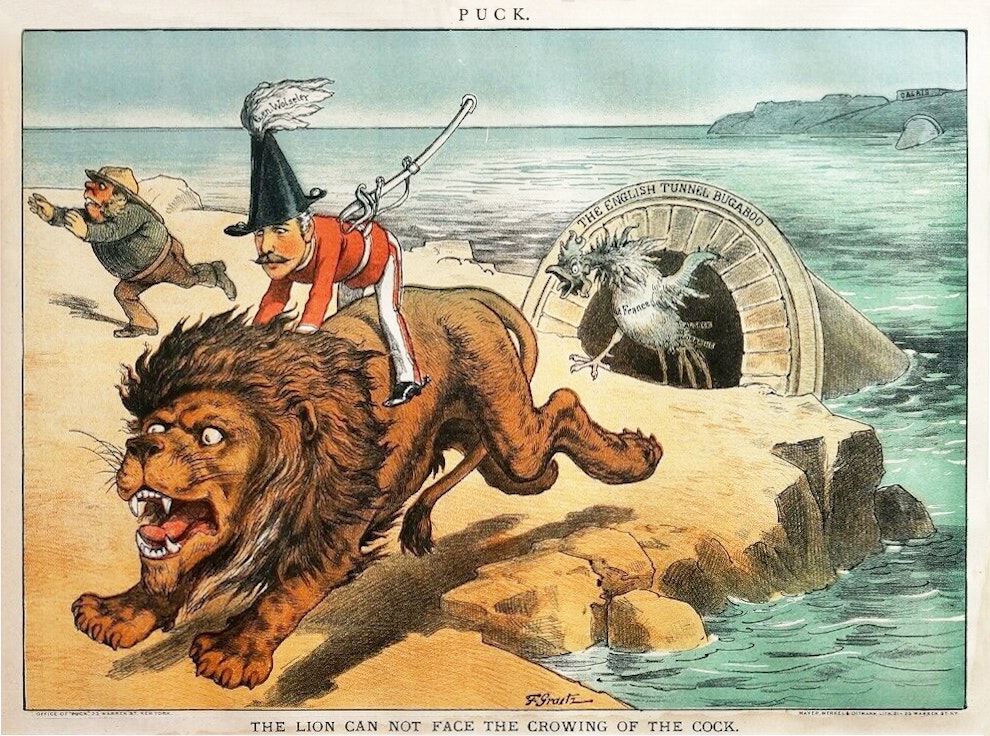 Scroll through the whole page to download all images before printing.
Scroll through the whole page to download all images before printing.“The Lion Can Not Face the Crowing of the Cock”, an illustration for a July 1883 issue of Puck by F. Graetz depicting General Wolseley fleeing the French coq on lionback, which was published the day after Edward Watkin’s Channel Tunnel (Experimental Works) Bill was withdrawn from Parliament. The tunnel’s inscription reads: “The English Tunnel Bugaboo” — Source.
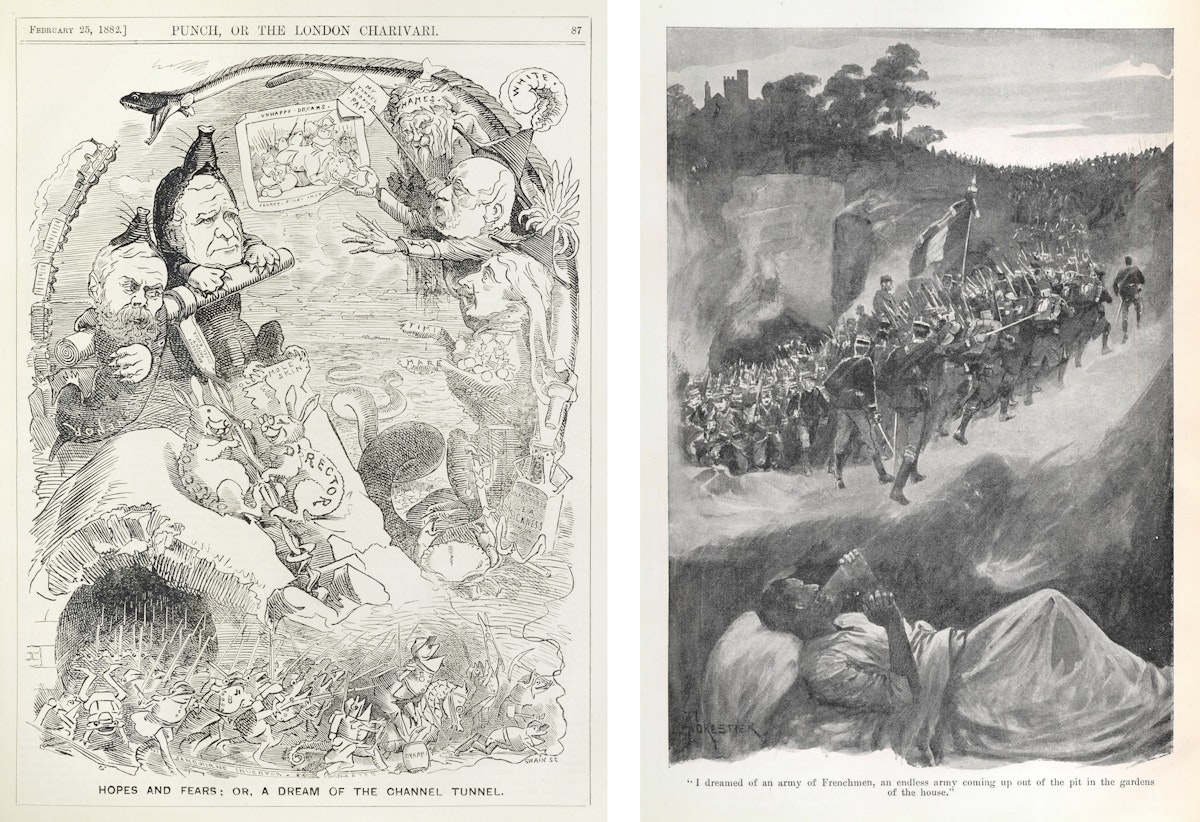 Scroll through the whole page to download all images before printing.
Scroll through the whole page to download all images before printing.Wolseley’s nightmare of a French invasion inspired a minor genre of xenophobic anti-Tunnel literature. Left: an illustration from an 1882 issue of Punch captioned “Hopes and Fears; or, a dream of the Channel tunnel”. Right: the hero of Max Pemberton's Pro Patria (1900) in Windsor Magazine has a vision of massing soldiers: “I dreamed of an army of Frenchman, an endless army coming up out of the pit in the gardens of the house” — Source: left, right.
But the real bite in Wolseley’s argument was not his future war scenario, but the analysis of British society. Personal freedom, low taxation, free trade, and a small army were made possible by the security offered by the Channel. By introducing the danger, however remote, of land invasion, the Tunnel would fundamentally upset this consensus. The result would infect the country with “panic, that horrid malady from which all nations having insignificant armies, and very powerful neighbours, suffer periodically”. Any movement by French troops near Calais might spark fear in Britain that an attack was imminent. The impossibility of developing a failsafe defence system would trap the nation into an escalating series of panics and enormous military spending programmes, with the result that the UK would eventually have to “imitate Continental nations” and establish a system of universal military conscription. As an aside, Wolseley asserted his belief that such an army would be impossible under “our form of government”, a suggestion that the Tunnel could do away with parliamentary democracy itself. The greatest threat posed by the Tunnel was not necessarily the horrors of an invasion, but the economic and societal cost of insuring against it.
Panic Petitions and Champagne Under the Sea
In February 1882, excerpts from Wolseley’s memorandum were published in The Nineteenth Century magazine, and over the following month he and other Army and Navy officers proceeded to conduct a coordinated public campaign against the Tunnel. In this they were aided by James Knowles, the editor of The Nineteenth Century, who organised a special edition and petition against the scheme, signed by many eminent, if not exactly representative, public figures, including a number of prominent liberals such as T. H. Huxley, Herbert Spencer, and fourteen Liberal MPs.27 The accompanying essay by Knowles, a diatribe against selfish “company-promoters”, boiled Wolseley’s arguments down to a trinity of terror: a “certainty” of increased military expenditure, a “probability” of panics, and “the possibility of an irretrievable disaster from invasion”. It was clear that the issue had struck something deep within the nervous system of liberal Britain. When it came to the point, many did not believe that “the people” would embrace their new continental connection in the spirit of universal brotherhood. “The alarmists sign [the petition] because they are alarmists”, reflected The Scotsman. “The non-alarmists sign because they do not wish the country to be alarmed.”28
Watkin responded to these attacks with every weapon in his arsenal. He encouraged his friends to write and speak in support of the Tunnel, and soon the papers and journals were consumed with debates about the scheme. He scored a particular success when Sir Andrew Clarke, the Commandant of the Royal School of Military Engineering, published a trenchant article assuring readers that there was no example in history of an entire army being deployed by a single railway line, and dismissing a potential secret invasion as a “simple impossibility”.29 More generally, Tunnel supporters pointed out that destroying, blocking, or flooding the Tunnel would be a trivial matter, especially considering the entrance fell under the guns of both Dover Castle and any warship anchored in the harbour.30 Watkin also employed softer means of persuasion, inviting a wide range of celebrities (including both Gladstone and Wolseley) to visit the Tunnel works underneath the sea, where they could enjoy a champagne reception and examine the boring machine in the glow of electric lights.
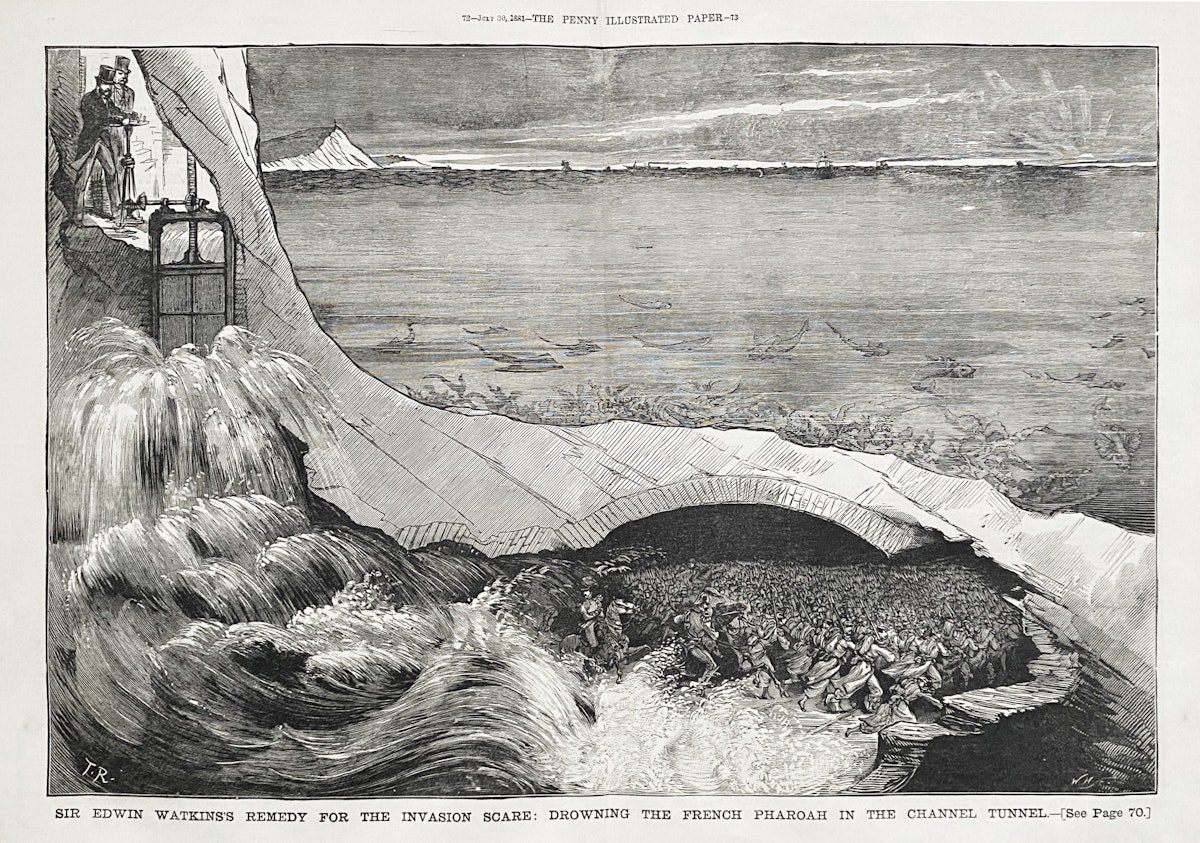 Scroll through the whole page to download all images before printing.
Scroll through the whole page to download all images before printing.“Sir Edwin Watkins’s Remedy for the Invasion Scare: Drowning the French Pharoah in the Channel Tunnel”, double-page drawing from an 1881 issue of The Penny Illustrated — Source.
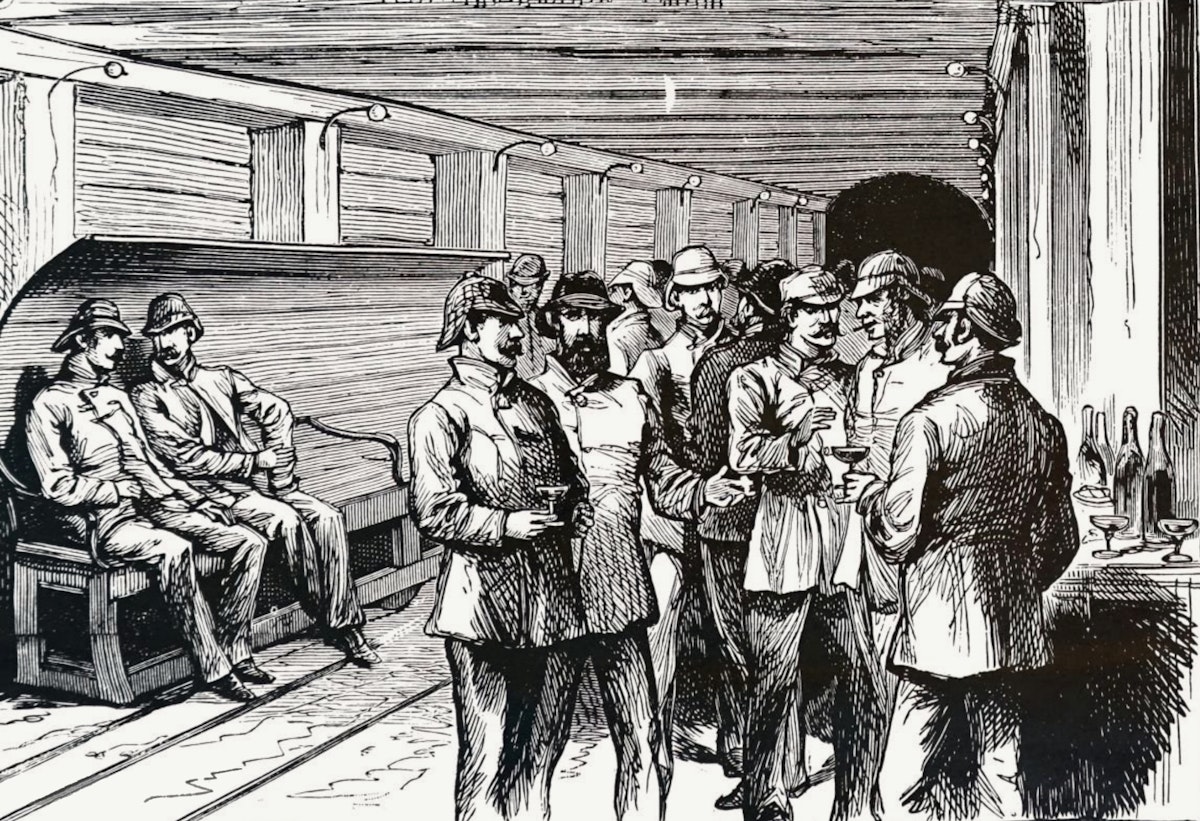 Scroll through the whole page to download all images before printing.
Scroll through the whole page to download all images before printing.Illustration of a champagne breakfast held in the Channel Tunnel, from an 1882 issue of The Illustrated London News — Source.
These rebuttals failed to stem the tide of public opinion, which, now obsessed with the fear of panic, flowed strongly against the Tunnel. Torn between his personal beliefs and political instincts, Gladstone shunted the issue to a Parliamentary select committee, who failed to come to an agreement, splitting six to four against the scheme. This was the excuse the government needed to extricate itself. Watkin’s Channel Tunnel (Experimental Works) Bill was formally withdrawn from the Commons on July 24, 1883.31
Work on the heading at Shakespeare’s Cliff had ceased in August 1882; the Board of Trade had eventually been forced to secure an injunction against Watkin, who at one point declared his willingness to go to jail for his Tunnel. When the machine at Sangatte was switched off on March 18, 1883, the two companies had tunnelled 3,863 yards (3.5 km) without serious incident.32 The French machine was soon moved to Liverpool, where it dug a ventilation tunnel for the Mersey railway. The British machine was left where it stood, 130 feet below the Channel.33 The name of the Submarine Continental Railway Company disappeared in 1886 when it merged with the Channel Tunnel Company. Watkin campaigned vigorously but fruitlessly for a further eight years. He retired from the railways in 1894, and died in 1901.
If the military objections had been withdrawn, could the Tunnel have been completed in the nineteenth century? Beaumont and English demonstrated how an undersea tunnel might be made, but their “experimental” works were miniscule compared to the full project. Watkin himself admitted that state support was probably necessary before the link could be finished. It is unlikely that Beaumont’s air-powered trains were viable at the scale envisaged, and the problem of continuous ventilation and maintenance would have been immense. On the other hand, the emergence of electric trains by the end of the century would have greatly simplified the problem.34 What is certain is that geology was on their side. At the end of the 1980s, during the construction of the modern Tunnel, a Eurotunnel/TransManche boring machine bisected the Submarine Continental’s heading under the sea.35 The 1882 works were found to be watertight, with rails and handcarts still in place: a reminder that people had come this way before.
Peter Keeling is a historian of UK politics and democracy. He holds a PhD in nineteenth-century British history from the University of Kent. His Linktree can be visited here.






